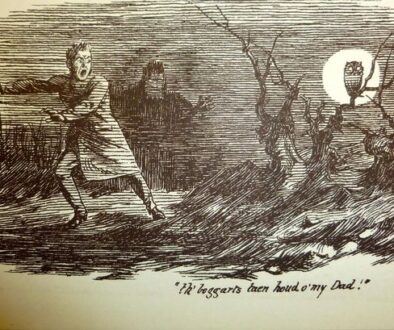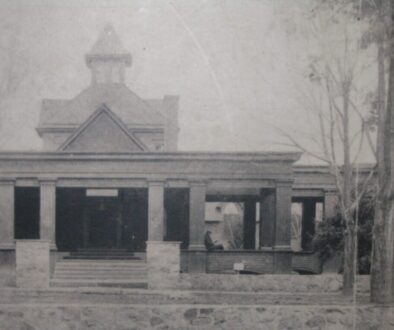A Glint at the Mound
[Readers may know me as a chronicler of other people’s supernatural experiences. They may not expect me to have my own. It’s true that I don’t have many. I believe I had such a moment recently by an ancient monument in southeastern Ohio.]
1
The state of Ohio is decked with the earthworks of the Hopewell culture often called “the Mound-Builders.” My home state of New York had quite a few of these human-made sacred spaces, too, when the whites arrived. I have to confess that Ohio has done a far better job of preserving and honoring them. Whenever I pass through Buckeye country I try to visit a site I’ve never seen – or else spend introspective time at a truly grand one, even if I’ve been to it many times.
The Hopewell monuments are mysterious. Not only is there uncertainty about their builders, their age, and their purposes, but people tend to have strange and potentially psychic experiences by things like them all over the world. The ancient monuments are places of “Exceptional Human Experience” in the terminology of British scholar Paul Devereux. Thats’s a nice ‘modern’ definition: it names what it intends to in a way that does not presume to understand what causes it.
Monumental complexes and ritual architecture typically do gather significant bodies of psychic/paranormal folklore. Stonehenge and the Great Pyramid are two examples that will probably resonate with anyone. It was that way with the smaller monuments, the mounds, stone circles, and earth-rings that might have been familiar only to the local populations. The difference was the scale of the storytelling, not the nature. The old stories linked the monuments to ghosts, witches, giants, wizards, dragons, fairies, and other figments of medievalesque folklore. Contemporary legend may include all that and add to it mystery-monsters, visionary/psychic experiences, UFOs – Yes, UFOs – and strange light effects often called Anomalous Light Phenomena (ALP). Anomalous Light Phenomena, also, is Paul Devereux’ term and his concept. Anomalous Light Phenomena are quite commonly reported at powerful haunted sights, too.
The long and the short of it is that when people spend time at “places of ancient sanctity” (a John Michell term) they tend to say they see things. They undergo what is to them exceptional experience. As an inveterate interviewer, I come across this pattern so much that I tend to expect it.
As to the causes of the potentially psychic effects of “places of ancient sanctity,” I have only speculation. Maybe it’s some feature of the geology, which does tend to be curious in the designated “hot spots” of ritual spaces. There could be some effect of physical form, of shape or proportion, that nurtures mood and impression for those within it. It could even be that the collective psychic power of generations of devotees, if there could be such a thing, lingers at a site and continues to impact the living.
I remember visiting monuments in the British Isles before knowing about the EHE-effect. I had a few intriguing, potentially extrasensory experiences. Stonehenge at the time was too industrialized to permit introspection, but I had some real trips at other monuments – Long Meg, the Rollright Stones, the White Horse of Uffington.
Until I recognized the pattern about the monuments, I considered those moments to be mere coincidences, if not simply my own impressions. I’d also had what I suspected might be at least unusual experiences at other places in the Isles. England is considered the world’s most haunted country, after all. By the time I stood in the eye of the Horse, however, I was sure I was getting faint suggestions of another realm that we can sometimes reach from this. At the very least, I had been sent into the trance state.
It would be an overstatement to suggest that everyone has exceptional experience at such places or even that sensitive individuals do so often. The monument, I think, just ups the odds. I also think the attempt could be overdone, like overplaying your favorite song. That’s something I never want to happen, with monuments or music. I do not overwhelm myself with time spent in ancient sacred space looking for revelations, even when I’m in Ohio.
One thing seems certain: There is no predictability about exceptional experience, even at powerful sites. That’s why TV-style ghost hunting seems so silly to me. EHE is rare, and it must be some combination of factors including at least time and place. And unquestionably, the quester has to be ready.
2
It was the afternoon of April 18, 2018, and my mind was in a singularly uncreative state. I had just finished a meeting in Marietta, Ohio, concerning a type of business I seldom engage in. I was sorting out facts and figures. Good deal? Bad deal? Go for it? Wait? I was trying to read signals. Who’s talking straight? Who’s playing me?
I was also scattered because of the travel. I’d been in and out of the car since I’d gotten up that day and more was to come. I figured I’d take advantage of the stop in Marietta to see something I had always been curious about.
The town of Marietta is interesting enough on its own. It has some glorious architecture. It may be the first town to be settled (1788) in the post-Revolution United States, at least as far as the Euroamericans are concerned. One of its resting places, Mound Cemetery, may hold the graves of more Revolutionary War officers than any other in the United States. This cemetery is named what it is because it was based around an ancient Hopewell earthwork that almost surely held burials.
It isn’t that unusual to find a white burial ground atop a Native one. The pattern is common all over the world. The supplanting culture reuses the space for the same purpose. You had a church here, we’ll give it one of ours. You had burial ground, we’ll have burial ground.
Two New York cemeteries rooted with mounds come to mind: Fort Hill in Auburn and the Buffum Street burying ground in South Buffalo. Fort Hill is large and sprawling. Its mound on top of a natural hill would be easy to miss. Buffum Street is small and bare, but you have to hunt for its mound, too. Many earthworks settle once the constructing culture stops maintaining them.
Hopewell monuments can be intricate.They can take the forms of people, animals, or geometric shapes. They can make complex statements with each other, with landscape features, or with astronomical events. Yet most of their statements seem to be made upward – to or in cooperation with the sky. At ground level, most of the Ohio monuments are low. You wouldn’t even know you what they are.
Marietta was once home to an impressive complex of Hopewell earthworks. Its first settlers gave them all Latin names. The namesake of this cemetery, this mound they call the Conus, is high. It reminds me of Silbury Hill in England, likewise conspicuously conical. This Conus is the lord of the landscape. It was resumed to be the burial-place of chiefs.
A pannier at the entrance tells you that the Conus could be fourteen hundred to almost three thousand years old. As you stride toward it, your first thoughts may be to appreciate the atmosphere around it. Mound Cemetery is wonderfully laid out. It has graceful Neoclassical-style markers and mausoleums. The old monument, though, stuns the eye.
As you approach the Conus you might wonder how it held its form through all the centuries. It is decked with a number of sturdy trees. Maybe their webbing roots help hold it in place.
The Conus is ringed by its own virtual moat, a four-foot-deep ditch. A gap, a dirt-bridge, leads to the base of the mound and is surely where the old-timers crossed. We do, too. It is here that the cement stairs were built that invite contemporary visitors to the leveled summit.
The Conus is one of the few ancient monuments on which it is customary to tread. Purists elsewhere consider such a thing irreverent if not offensive to the dead. At the Conus, the railing makes it easy, and the flattened summit has been made hospitable. Its three benches invite people to brood and linger. In the turf between them is a plaque proclaiming the deposit of a time-capsule in 1976, the year of the nation’s bicentennial.
3
Journal in hand, I stood at the top, my mind still in the whirl I have described to you earlier. I would have had to sit for an afternoon before transcendence had a chance to come over me, and I had just a few minutes. These are not the circumstances of vision. I wondered whether I should even make the effort.
The Conus stands, they say, only thirty feet. It feels taller when you’re atop it. The graves of the cemetery below arc from it like the wake of a stone dropped in water. It’s a sublime vantage.
That was also a beautiful afternoon, and I had no idea when I would be there again. I took a seat on the bench directly behind the plaque as one reads it. I opened my journal and made a few jots about where I was and what I was feeling. It was around 1:40.
At first, only perception streamed. The inner dialogue faded. I was all eyes and ears and sensations. Then, quickly, maybe only three minutes in, I saw it.
Over the plaque and maybe fifty feet distant was a curious red glint that appeared to me through a chink in the branches of two large, well-spaced trees at about the altitude of my eyes and in the direction I was looking. Its source seemed to be in the air behind the closest tree. It was unnatural. It was like someone had shined a penlight through a ruby. The radiance lasted about three seconds, and when it blinked out I craned around to see if I could spot it again. I could not. I analyzed the experience.
The light’s position had been unusual, seemingly a point in the air behind the first tree and before the second. The one in back was an evergreen; the one nearest was bare and grey and possibly dead. Twenty feet of stillness stood between them. I’m not sure I would have seen the light if it had not appeared right where I was looking. It was as if something had been signaling to me.
I looked for material explanations. Don’t suggest a laser-pointer on somebody’s porch. This was more of a glint or a glare than a beam. Besides, a laser glow is hostile. This was warm. Nurturing.
Don’t suggest a glassy gem hanging forty feet up and suddenly catching a beam of sunlight. That’s what the glint would have looked like, but what would it hang on in mid-air?
Could it have been something reflective on one of the porches on the street eighty yards away? As unlikely as that seems, I checked for it as I drove away. I saw nothing on any of the houses that could have been in my line of sight during the experience.
You would classify my sighting as “anomalous light phenomena,” ALP, which is reported very rarely if ever during the day. There was nothing grand about it. It was no major insight or apparition, and it led me to no sweeping resolution about anything. It was just a red gleam.
There are many ways of processing what I think I witnessed. What do I take from it besides the possibility that it was all illusion? It’s the same feeling I had at the instant. I took it as a greeting, one I would never have been given if the path I have chosen wasn’t a good one. It seemed to say to me that I am still on it. And that sometimes the eternal powers take pity on us and give us all we can receive of vision in spite of ourselves.
When I reached into a pocket of my jacket a little later I found that I had lost the pen with which I had written in my journal. Surely it rested among the grass blades of the fine old cemetery, possibly back on the mound itself. It was a freebie from an old Vermont inn I sometimes visit during ski season. It was a slick, black slender thing, though, that fit my hand and made a fine line. I always liked writing with it. Its loss could be taken as a sacrifice, something left behind that I’d have preferred to keep. It was a small one, though, and a small return for the moment I had been given.
The photograph to the left above is a shot of the mound as I approached the stairs. The one to the right was taken from where I sat at the top. I Photoshopped it to show the spot at which I saw the red light-form glaring through the branches.




